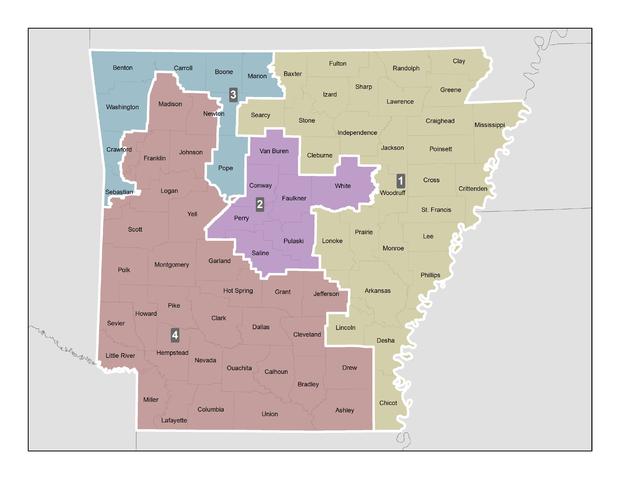Redistricting Journal: New Indiana map bolsters Republican prospects
Mark Gersh is Washington Director of the National Committee for an Effective Congress, and a CBS News Consultant. This is the first installment of a new weekly Hotsheet series on redistricting battles across the country.
Six states have finished congressional redistricting to date, and it's becoming clear that redistricting, as expected, is going to have an impact on House competitiveness next year and have set up a few interesting battlegrounds, as well as some surprises.
Looking first at the states finalizing the process in the last month, Indiana generated the most substantial impact to the complexion of the next Congress. Indiana (awarded nine congressional districts) and Missouri (with eight, having lost one seat) are the largest states to finalize the construction of new districts.
Controlled by a Republican governor and legislature, Indiana's new map bolstered Republican prospects. For starters, Democrat Joe Donnelly, who narrowly avoided defeat in 2010, gained solidly Republican voters from Elkhart while losing democratic strongholds in Lapodte County. Overall, it is estimated the new 2nd district is five percent more favorable for Republicans. Perhaps consequently, Donnelly decided to run for the Senate, where Republican Richard Lugar faces a serious primary challenge. As for the 2nd district, Republican Jackie Walorski would be favored to win the seat next November.
Two other notable consequences of the new map: Republican Todd Young was accorded a substantially more Republican constituency in the southern Indiana 9th district, while Republican mapmakers accorded no favors for freshman Republican Larry Buschon, in the Evansville based 8th district. He now faces serious Democratic opposition based on the partisan profile of the new territory. Both the 8th and 9th districts have been revolving doors for both parties over the past 20 years. At least the 9th district now seems out of reach for the Democrats.
In Missouri, Republicans overrode a veto by Democratic Gov. Jay Nixon, enacting a partisan Republican plan. The remap was devastating news for 3rd district Congressman Russ Carnahan, who saw his district essentially merged with the 1st district represented by Democratic Lacy Clay. Containing virtually all of the St. Louis area African-American population, Carnahan would be the underdog if he entered the 1st district primary.
Alternatives for Carnahan includes legal action, arguing that the overall plan violates redistricting principles, by creating incongruous communities of interests, diluting the interests of the St. Louis area, or seeking reelection in the second district. The incumbent representative in the 2nd district, Republican Todd Akin, has declared his candidacy for the Senate seat currently held by Democrat Claire McCaskill. Any Republican would start off as the favorite in the newly designed 2nd district. The other six Missouri districts are likely to reelect five Republican incumbents and a second Democrat, Emmanuel Cleaver, in the Kansas City based 5th district.
Meanwhile, in Texas, where Republicans control the three branches of government, is struggling to approve a map, with the likelihood of court intervention growing by the day. By far the biggest winner of the reapportionment process, Texas will add four seats to its delegation, already second only to California, and will elect 36 members of Congress in 2012.
Redistricting analysts have also been paying close attention to New York. The upset victory of a Democrat in last Tuesday's special election has complicated an already opaque redistricting landscape. New York loses two seats, and will be tied with Florida, for the third largest congressional delegation at 27 districts.
Meanwhile, Arkansas' final map (at left) resembles the non-partisan Iowa map, in that 3 of the 4 districts should be highly competitive. (Iowa was analyzed in a previous redistricting story in Hotsheet). The 1st and 2nd districts in Arkansas, both won by freshmen Republicans in the 2010 GOP landslide, will remain competitive. Both Rick Crawford and Tim Griffin are likely to face vigorous Democratic challenges.
Iowa House races could be among 2012's most competitive
Somewhat surprisingly, the Democratic controlled legislature and governor slightly weakened Democratic long-term incumbent Mike Ross in the 4th district. Ross, a popular figure, is seriously contemplating a gubernatorial race in 2014. First, he must fight off a potential Republican challenge in the newly designed 4th district. Republicans are virtually assured of holding the 3rd district based on the partisan patterns.
Oklahoma's five districts were drawn to virtually replicate the current map - four Republican and one Democratic member of Congress are strong favorites for reelection.
After a long struggle, Republicans passed a map in Louisiana that extended the New Orleans African-American based 2nd district from New Orleans, north to Baton Rouge. That move was warranted in order for the district to retain its African-American majority. Partially attributable to the aftermath of Hurrican Kartrina, the current 2nd, represented by Democrat Cedric Richmond, is the nation's most sparsely populated district.
The other salient development in Louisiana was the merger of two Republicans, Chalres Boustany and Greg Landry. Heretofore representing the 3rd and 7th districts respectively, the two incumbents will compete for the Republican nomination in the newly numbered 6th district. Although Republicans are prohibitive favorites to retain the other four congressional districts, a growing African-American population might offer competition for Republicans in the 4th district.
Overall: Democrats are likely to lose a seat in Missouri and Indiana, while Republicans face a loss in Louisiana. Both Iowa and Louisiana have now set the stage of incumbent versus incumbent battles: a Republican primary in Louisiana (Boustany versus Landry) and a high profile showdown in Iowa between Democrat Leonard Boswell and Republican Thomas Latham.
Groups opposed to partisan gerrymandering and eager for more competitive districts, should find hope in the expansion of potentially competitive races: 4 in Iowa, 3 in Arkansas, 1 or 2 in Indiana and potentially 1 in Missouri and perhaps Louisiana.
Looking ahead: Right now many eyes are on Illinois. The critically important Illinois map is expected to be approved by the governor this week. Illinois represents the best prospect for Democrats to gain new seats -- the party controls the governor's office and both Houses of the state legislature. Faced with the prospect of losing seats in states like North Carolina, Pennsylvania and Michigan, Illinois is an integral element in the Democratic Party's ability to avoid a net loss of districts nationwide and we'll review it as soon as it's fully approved.
One more fascinating scenario will unfold in Wisconsin as well, where Republicans who control the process may have some decisions to make about how to draw lines that could help some of their House members while making it tougher for others. Notably, what will the impact be of Paul Ryan's Medicare proposal on Wisconsin redistricting? Will the GOP legislators boost Ryan's reelection prospects in what is a marginal constituency? Ryan has easily won reelection in recent years. Will the Wisconsin environment endanger one of the GOP's most important leaders? And will any desire to boost Ryan jeopardize Republican aspirations to endanger 3rd district Democrat Ron Kind, and secure freshman Republican Sean Duffy, in the 7th district nearby? Stay tuned!

